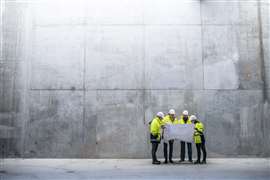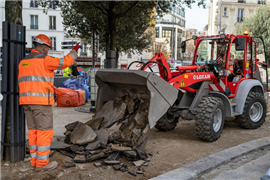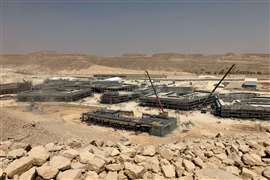7 construction megaprojects that severely overran their budget
28 July 2023
Following on from International Construction’s recent article on why megaprojects go wrong and the ingredients for success, this week we examine some of the biggest budget overruns on projects.
We’ve looked at seven major projects over the last few decades that have not only seen delays but have significantly exceeded their original projected cost.
Rather than ranking these by absolute cost, they are ranked by how many times the final cost exceeded the original budget.
7) The Channel Tunnel (1.7x budget)
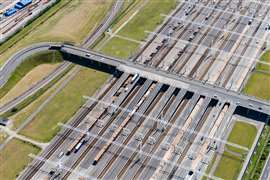 Aerial image of Channel Tunnel complex in Folkestone, UK (Image: Sebastian via AdobeStock - stock.adobe.com)
Aerial image of Channel Tunnel complex in Folkestone, UK (Image: Sebastian via AdobeStock - stock.adobe.com)
A consortium of British and French companies called Transmanche Link (TML) built the 50km-long undersea Channel Tunnel from Folkestone in the UK to Coquelles in France.
It involved British, French, and Belgian companies such as Sir Robert McAlpine, Bouygues, and Dumez.
Work started in 1988 and the tunnel opened in 1994.
The total cost of the project was £9.5 billion (equivalent to £21.8 billion in 2021), which was far over the original budget of £5.5 billion.
Part of the reason for the cost overrun was the fact that the geology of the Channel was more complex than expected. Five tunnel boring machines (TBMs) dug from France, with six TBMs digging from the UK. Ground conditions at the French end of the tunnel were wetter, making progress on the French side slower.
The tunnel had to be built through a variety of different geological formations, including chalk, clay, and sand, making construction more difficult and expensive.
As with other projects on this list, bad weather and labour disputes all played a part in slowing down the construction programme.
Despite the cost overruns, the Channel Tunnel ultimately proved a successful project.
The American Society of Civil Engineers elected the Channel Tunnel one of the ‘seven modern wonders of the world’ in 1994. It is a vital link between Britain and France, and it has generated an estimated £25 billion in economic activity.
6) Berlin Brandenburg Airport (2.1x budget)
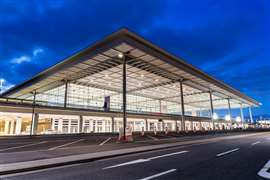 Passenger terminal at Berlin Brandenburg airport (Image: Riko Best via AdobeStock - stock.adobe.com)
Passenger terminal at Berlin Brandenburg airport (Image: Riko Best via AdobeStock - stock.adobe.com)
Construction on Berlin Brandenburg Airport began in 2006, ahead of what was originally supposed to be completion in 2011.
But the airport in fact only became operational in October 2020.
That was after a series of delays which sent the budget spiralling from €2.83 billion to around €6 billion – more than double the original estimate.
The airport faced a series of construction and technical challenges, including problems with fire safety systems, baggage handling, and ventilation. The cost of soundproofing nearby homes also ballooned.
Rectifying these issues and bringing the airport up to safety and operational standards required significant additional investments.
And the airport’s design and the scope of the project also changed, pushing costs upwards. These changes included modifications to terminal layouts, security infrastructure, and expansion plans to accommodate projected passenger volumes.
The consolidated airport has nonetheless replaced the ageing Tegel and Schönefeld airports. Efforts are now underway to learn from the project’s challenges to improve project management and oversight in future airport developments.
5) New York MTA East Side Access (2.7x budget)
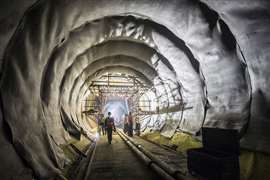 A worker in a tunnel during construction of the MTA’s east side access project (Metropolitan Transportation Authority of the State of New York, CC BY 2.0, via Wikimedia Commons)
A worker in a tunnel during construction of the MTA’s east side access project (Metropolitan Transportation Authority of the State of New York, CC BY 2.0, via Wikimedia Commons)
The New York Times has described the New York Metropolitan Transportation Authority (MTA)’s East Side Access project as “the most expensive mile of subway track on earth”.
The project extends the Long Island Rail Road (LIRR) two miles from Queens to the new Grand Central Madison station under Grand Central Terminal on Manhattan’s East Side.
Construction started in 2007 and full service finally began in February this year. The cost of the project rose from the US$4.3 billion originally estimated in 2001, to $11.6 billion.
The near $12 billion cost worked out at $3.5 billion per mile of new tunnel, the New York Times reported.
Work involved extensive tunnelling, excavation, and construction work in a densely populated urban environment, ramping up its complexity and increasing costs.
Building new underground infrastructure beneath an established transportation network also required careful engineering and coordination.
By 2012, the US Department of Transportation’s Inspector General demanded an audit on the project, after it learned of a 14-year delay and 100% cost increase.
Poor management and a lack of oversight on New York transportation projects were blamed, as well as claims that contractors in the city were paid more than in other US cities and that politicians and trade unions had forced the MTA to hire more workers than were needed.
Work to add two bypass tunnels within the Harold interlocking railroad junction – the busiest rail junction in the United States – also proved costly.
Around $295 million was allocated for the bypass in 2011 but by 2015 the tunnels fell behind schedule because Amtrak and the MTA could not agree on track access schedules. The delays raised construction costs by almost $1 billion alone.
4) Montreal Olympics (5x budget)
 Montreal’s Olympic stadium (Image: Delphotostock via Adobe PhotoStock - stock.adobe.com)
Montreal’s Olympic stadium (Image: Delphotostock via Adobe PhotoStock - stock.adobe.com)
Inflation and a complex stadium build dogged preparations for the 1976 Montreal Olympics in Canada.
The cost of construction work, including materials and labour, soared during work to build several new facilities for the games, including a velodrome, swimming pool and stadium, as prices in the 1970s rose rapidly.
While the budget for the games was originally set at CAN$300 million, it ballooned to $1.5 billion.
A significant proportion of the final cost was taken up by the stadium, which ended up costing around CAN$770 million to build. The stadium had been due to be completed in 1972 but was hampered by worker strikes, escalating costs of raw materials and bad weather.
French architect Roger Taillibert’s complex design involved a retractable roof which was to be opened and closed by cables suspended from a 165m tower. But the Quebec government removed Taillibert from the project in 1974 and the stadium and tower were not fully completed until 1987. The roof only became retractable in 1988.
The games were a success but left the City of Montreal with a debt of CAN$1.5 billion, which took decades to pay off.
3) Flamanville EPR nuclear power plant (5.8x budget)
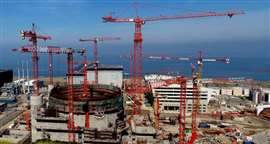 Construction of the EPR nuclear power plant at Flamanville, France (Wikipédia, CC BY 3.0, via Wikimedia Commons)
Construction of the EPR nuclear power plant at Flamanville, France (Wikipédia, CC BY 3.0, via Wikimedia Commons)
France’s Flamanville European pressurised reactor (EPR) nuclear power station in Normandy finally looks set to be commissioned this year.
A consortium between Bouygues Travaux Publics, Quille Construction and DTP started civil engineering work for client EDF in 2007.
But the complexity of the technology involved in the advanced reactor, which boasts enhanced safety features, has presented challenges.
Technical issues, regulatory hurdles, labour disputes, and the need to address quality control concerns have also slowed down construction work.
France’s Nuclear Safety Authority (ASN) raised concerns that there were defects in the steel used to make parts of the reactor pressure vessel, including the lid. After carrying out various tests, ASN finally gave the go-ahead for EDF to commission the reactor pressure vessel in 2018, adding to the delays.
The cost of the project is now estimated at €19.1 billion, against the original estimate of €3.3 billion.
2) Scottish Parliament Building (10x budget)
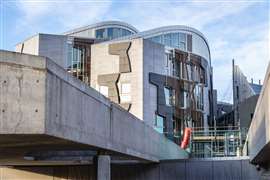 Exterior of the Parliament of Scotland building in Edinburgh (Image: Fotokon via AdobeStock - stock.adobe.com)
Exterior of the Parliament of Scotland building in Edinburgh (Image: Fotokon via AdobeStock - stock.adobe.com)
Ahead of a referendum in 1997 on whether there was support for the creation of an independent Scottish Parliament, the estimated cost of constructing a new building to house it was £10-40 million.
But by the time the Scottish Parliament at Holyrood in Edinburgh was officially opened in 2004, that figure had spiralled to £414 million.
The building, designed by Catalan architect Enric Miralles and built by main contractor Bovis Lend Lease was far more complex than originally thought.
The project moved forward on a construction management method basis, under which the client retained full control but also carried all of the risk.
Meanwhile, challenging architectural features, including an asymmetrical design, the requirement to use Scottish materials, design changes requested by Scottish members of Parliament, bad weather, and labour disputes all conspired to delay the project. Miralles also died four years before the project was completed.
Nonetheless, the building eventually won the coveted ‘Stirling Prize’ for architecture in 2005 and despite its notoriety for cost overruns at the time, it has proven to be a popular visitor attraction in Scotland.
1) Sydney Opera House (14.6x budget)
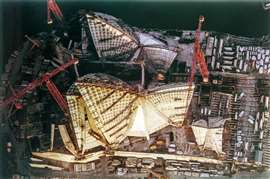 The Sydney Opera House under construction in 1965 (Image: Len Stone photograph collection, CC BY 4.0 via Wikimedia Commons)
The Sydney Opera House under construction in 1965 (Image: Len Stone photograph collection, CC BY 4.0 via Wikimedia Commons)
Given its iconic status as one of Australia’s most recognisable landmarks, it is easy to overlook the fact that its long and complicated construction ran hugely over budget.
Construction work started in 1959 and did not finish until 1973. The total cost of the building, at A$102 million, was far in excess of the original budget of A$7 million.
The unusual building features ‘sails’ made from 2,194 precast concrete panels, along with a concert hall boasting unique acoustic properties.
Those challenging architectural features slowed down the construction of the building, as did bad weather and the modification of designs.
The original architect, Jørn Utzon, resigned from the project in 1966 amid political pressure surrounding concerns over the mounting costs.
Later in the construction, there were also labour disputes. At one point, in 1972, workers protesting the dismissal of a colleague and demanding a wage increase expelled management from the site and continuing work under workers’ control for over a month between April and May.
Despite the cost overruns, the Sydney Opera House came to be regarded as a successful project. It is a popular tourist destination and a UNESCO World Heritage Site.
The building has also been praised for its architectural design and its acoustic qualities and in 2022 it was recognised as an International Historic Civil Engineering Landmark by the American Society of Civil Engineers (ASCE).
STAY CONNECTED


Receive the information you need when you need it through our world-leading magazines, newsletters and daily briefings.
CONNECT WITH THE TEAM









